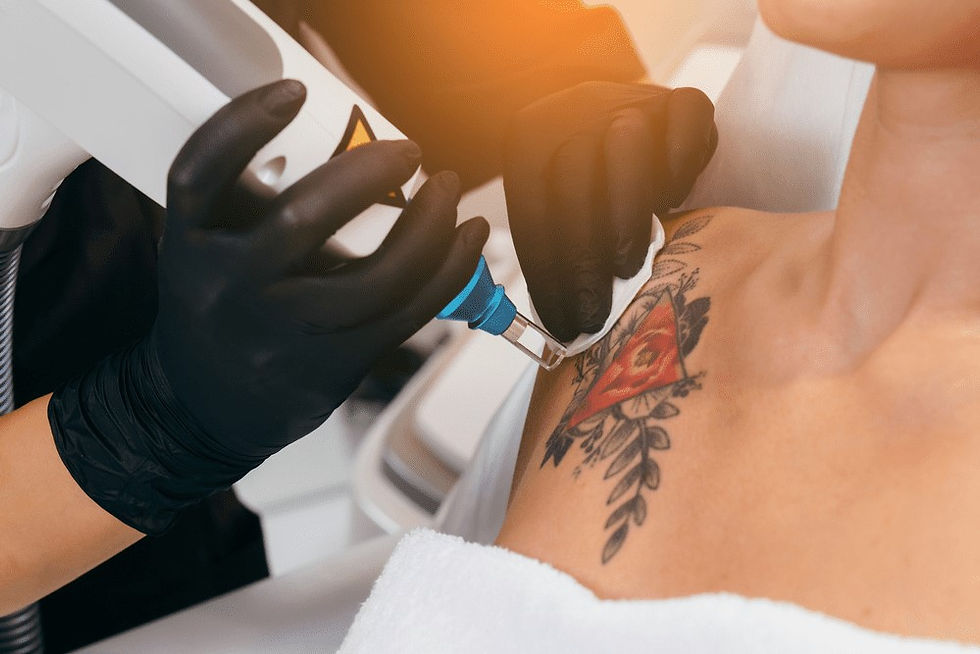Transform Your Skin with Laser Tattoo Removal
- danyalmalikdynamic
- Aug 22, 2024
- 4 min read
Tattoos have become a form of self-expression, art, and identity for many. However, as times change and personal preferences evolve, some individuals may find themselves regretting their ink. Thankfully, laser tattoo removal has emerged as a revolutionary solution, offering a path to clear, unblemished skin. This article delves into the transformative journey of Laser Tattoo Removal in Dubai, explaining how it works, its benefits, and what to expect during the process.
Understanding Laser Tattoo Removal
The Science Behind Laser Tattoo Removal
Laser tattoo removal involves the use of high-intensity laser beams to break down the ink particles embedded in the skin. The process works through a technique called selective photothermolysis, where the laser targets the ink pigment while leaving the surrounding skin unharmed. The light energy from the laser is absorbed by the ink particles, causing them to fragment into smaller pieces. These smaller particles are then gradually eliminated by the body’s natural processes.

Types of Lasers Used
Several types of lasers are employed in tattoo removal, each designed to target specific ink colors and types. The most common lasers include:
Q-Switched Nd Laser: This laser is highly effective for dark colors like black and blue. It emits short bursts of energy that can penetrate deep into the skin to target the ink.
Q-Switched Ruby Laser: Ideal for red and orange inks, this laser uses a ruby crystal to produce a specific wavelength that is absorbed by these colors.
Q-Switched Alexandrite Laser: This laser is particularly effective for green and blue inks. It has a wavelength that is absorbed well by these colors, making it a versatile choice.
Each laser type is selected based on the specific color and depth of the ink, ensuring optimal results and minimal skin damage.
Benefits of Laser Tattoo Removal
Precision and Effectiveness
One of the primary advantages of laser tattoo removal is its precision. The laser targets only the ink particles, leaving the surrounding skin intact. This precision allows for the effective removal of tattoos with minimal risk of scarring or pigmentation changes.
Minimal Downtime
Unlike surgical tattoo removal methods, laser tattoo removal requires minimal downtime. Most patients experience only minor discomfort and can resume their daily activities shortly after the procedure. The treatment involves multiple sessions, but each session is relatively quick and non-invasive.
Improved Skin Appearance
Successful laser tattoo removal can lead to a significant improvement in skin appearance. As the ink is broken down and absorbed by the body, the skin gradually returns to its natural state. This process can restore the skin’s smoothness and clarity, giving it a rejuvenated appearance.
The Laser Tattoo Removal Process
Initial Consultation
The journey to clearer skin begins with an initial consultation with a qualified practitioner. During this appointment, the practitioner assesses the tattoo, discusses the patient’s medical history, and determines the appropriate laser treatment based on the tattoo's size, color, and depth. This consultation also provides an opportunity for patients to ask questions and understand the procedure better.
The Procedure
On the day of the procedure, the area around the tattoo is cleaned and a topical anesthetic may be applied to minimize discomfort. The laser is then used to target the ink, with each pulse lasting only a fraction of a second. The procedure is generally well-tolerated, though some patients report a sensation similar to the snapping of a rubber band against the skin.
Post-Treatment Care
After the laser treatment, patients may experience redness, swelling, and mild discomfort in the treated area. These effects are temporary and typically subside within a few days. It’s essential to follow post-treatment care instructions, which include keeping the area clean, avoiding direct sun exposure, and applying any recommended ointments.
What to Expect After Treatment
Healing and Recovery
The healing process following laser tattoo removal varies from person to person. The treated area will gradually scab and peel as the ink particles are eliminated. It’s crucial to avoid picking at scabs to prevent scarring. Most patients notice gradual fading of the tattoo over several sessions, with the final result being a significantly lighter or completely removed tattoo.
Session Frequency and Results
Laser tattoo removal usually requires multiple sessions to achieve optimal results. The number of sessions needed depends on various factors, including the tattoo’s size, color, and age. Sessions are typically spaced 6-8 weeks apart to allow the skin to heal and the body to process the ink particles. Patience is key, as complete removal can take several months.
Risks and Considerations
While laser tattoo removal is generally safe, some risks and side effects include temporary discoloration, scarring, or changes in skin texture. Choosing a reputable and experienced practitioner can help minimize these risks. It’s also important to adhere to aftercare instructions to ensure the best possible outcome.
Conclusion
Laser tattoo removal offers a promising solution for those seeking to transform their skin by erasing unwanted tattoos. Through advanced technology and precise techniques, individuals can achieve a clearer, more rejuvenated appearance while enjoying minimal downtime and effective results. If you're considering laser tattoo removal, consult with a qualified specialist to determine the best approach for your specific needs and embark on the journey to reclaiming your skin’s natural beauty.
Comments